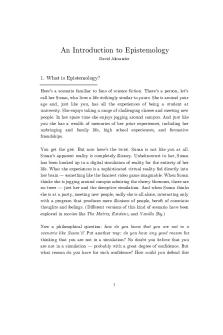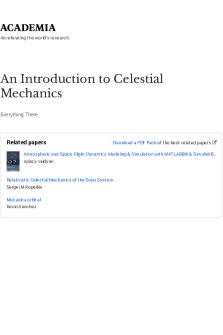An Introduction to Well Integrity PDF

| Title | An Introduction to Well Integrity |
|---|---|
| Author | Tulio Wever 1 |
| Pages | 154 |
| File Size | 4.1 MB |
| File Type | |
| Total Downloads | 347 |
| Total Views | 470 |
Summary
An Introduction to Well Integrity Rev 0, 04 December 2012 0 Preface This document has been prepared as a joint project between members of the Norwegian Oil and Gas Association's Well Integrity Forum (WIF) and professors at NTNU and UiS. The intention with the document is to provide a document th...
Description
An Introduction to Well Integrity Rev 0, 04 December 2012
0
Preface This document has been prepared as a joint project between members of the Norwegian Oil and Gas Association's Well Integrity Forum (WIF) and professors at NTNU and UiS. The intention with the document is to provide a document that can be used in educating personnel in well integrity and especially students at the universities.
Authors of this document have been:
Hans-Emil Bensnes Torbergsen, Eni Norge
Hilde Brandanger Haga, Statoil
Sigbjørn Sangesland, NTNU
Bernt Sigve Aadnøy, UiS
Jan Sæby, Shell
Ståle Johnsen, Total
Marvin Rausand, NTNU
Mary Ann Lundeteigen NTNU
0
04.12.12
Original document
Revision
Date of issue
Reason for Issue
1
Index Preface ................................................................................................................................................ 1 List of Abbreviations ................................................................................................................................ 6 List of figures ............................................................................................................................................ 1 List of Tables ............................................................................................................................................ 4 1.
What is well integrity? (Well integrity – concepts and terminology) ........................................... 5
2.
Background and History ................................................................................................................... 8
3.
2.1
What can go wrong in wells?................................................................................................. 9
2.2
How likely is loss of well integrity? ...................................................................................... 10
2.3
What are the consequences of loss of well integrity? ........................................................ 11
2.4
Some cases of loss of well integrity ..................................................................................... 12
2.4.1
Case 1: Failure of surface casing and drop of wellhead.............................................. 12
2.4.2
Case 2: Failure of production casing hanger............................................................... 15
2.4.3
Case 3: Loss of wellbore .............................................................................................. 17
2.4.4
Case 4: Gas leaks in tubing strings .............................................................................. 20
2.4.5
Case 5: Production casing failure ............................................................................... 25
2.4.6
Case 6: Well failure .................................................................................................... 26
Well Construction and Field Development .................................................................................... 29 3.1
Well Types and Well Life Cycle ............................................................................................ 29
3.2
Subsea drilling ..................................................................................................................... 29
3.3
Platform drilling .................................................................................................................. 35
3.4
Subsea Well Completion ..................................................................................................... 35
3.4.1 3.5 4.
Types of X-mas trees for subsea wells ........................................................................ 36 Surface well completion ...................................................................................................... 40
Well Barriers – definitions, classification, and requirements.................................................. 45 4.1
Key concepts and definitions............................................................................................... 45
2
4.2
Well Barrier Requirements .................................................................................................. 46
4.3
Well Barrier Functions ......................................................................................................... 47
4.4
Well barrier schematics and diagrams ................................................................................ 49
4.4.1
Well barrier schematics .............................................................................................. 50
4.4.2
Well barrier diagrams ................................................................................................. 51
4.5 4.5.1
Reliability analysis of well barriers .......................................................................... 53
4.5.2
Analysis steps .............................................................................................................. 53
4.6
Identification of barrier functions ....................................................................................... 55
4.7
Failure and failure analysis ................................................................................................ 56
4.7.1
Key terms and definitions ........................................................................................... 56
4.7.2
Classification of failure modes .................................................................................... 58
4.8 4.8.1 4.9
5.
Reliability analysis and methods ......................................................................................... 53
FMECA ................................................................................................................................. 60 FMECA procedure ....................................................................................................... 61 Fault tree analysis ................................................................................................................ 68
4.9.1
Fault tree programs .................................................................................................... 70
4.9.2
Fault tree construction ............................................................................................... 70
4.9.3
Fault tree pros and cons ............................................................................................. 74
4.9.4
Qualitative analysis of the fault tree........................................................................... 74
4.9.5
Failure rate, mean time to failure, and survival probability ....................................... 75
4.9.6
Well barrier performance data ................................................................................... 76
4.9.7
Quantitative analysis .................................................................................................. 77
Technical well barriers ................................................................................................................... 80 5.1
Well barrier philosophy ....................................................................................................... 80
5.1.1
Fail-safe functions: ...................................................................................................... 80
5.1.2
Safety systems ............................................................................................................ 81
5.1.3
Fire resistance ............................................................................................................. 81
3
5.1.4
Well barrier schematics .............................................................................................. 82
5.1.5
Drilling phase .............................................................................................................. 87
5.1.6
Completion phase ....................................................................................................... 89
5.1.7
Production phase ........................................................................................................ 91
5.1.8
Intervention phase ...................................................................................................... 93
5.1.9
P&A phase ................................................................................................................... 95 Barrier design, construction and qualification of barriers for life cycle ........................... 97
5.2 5.2.1
MWDP or MSDP .......................................................................................................... 97 Description of typical barrier elements and important qualification issues ...................... 98
5.3 5.3.1
Formation ................................................................................................................... 98
5.3.2
Casing Cement .......................................................................................................... 101
5.3.3
Casing Cement Plug .................................................................................................. 103
5.3.4.
Casing/Tubing ........................................................................................................... 104
5.3.5.
Production packer ..................................................................................................... 106
5.3.6.
DHSV ......................................................................................................................... 107
5.3.7.
CIV ............................................................................................................................. 108
5.3.8.
Casing hanger seal .................................................................................................... 109
5.3.9.
Wellhead ................................................................................................................... 110
5.3.10. 6.
Annulus valves ...................................................................................................... 111
Operational .................................................................................................................................. 116 6.1.
General ............................................................................................................................ 116
6.2.
Valves and Christmas Trees ............................................................................................ 117
6.2.4.
Valve Test Criteria ..................................................................................................... 117
6.2.5.
Subsurface Safety Valves (SSSV) ............................................................................... 119
6.2.6.
Annular Safety Valve (ASV) ....................................................................................... 122
6.2.7.
X-mas tree ................................................................................................................. 122
6.2.8.
Annulus Valves .......................................................................................................... 123
4
6.2.9. 6.3.
8.
9.
Pressure Monitoring ........................................................................................................ 123
6.3.1.
Annulus Pressure Surveillance Principles ................................................................. 123
6.3.2.
Types of annular pressures ....................................................................................... 124
6.3.3.
Calculation of MAASP ............................................................................................... 134
6.3.4.
Setting of Maximum Operational Pressure (MOP) ................................................... 137
6.3.5.
‘A’ Annulus MINAP (gas lifted wells)......................................................................... 137
6.3.6. 7.
Gas Lift Valves ........................................................................................................... 123
Management and Control......................................................................................... 138
Organizational ................................................................................................................................. 140 7.1.
Roles and responsibilities......................................................................................................... 140
7.2.
Competence and training ......................................................................................................... 141
Appendix A - Homework problems ..................................................................................................... 142 8.1.
Exercise 1 ......................................................................................................................... 142
8.2.
Exercise 2............................................................................................................................. 144
8.3.
Exercise 3: ......................................................................................................................... 144
8.4.
Exercise 4 .......................................................................................................................... 145
References .................................................................................................................................... 146
5
List of Abbreviations ACV Annulus Circulation Valve
GLV Gas Lift Valve
AIV Annulus Isolation Valve
HMV Hydraulic master valve
AMV Annulus Master Valve
HPA High Pressure Alarms
AP Applied Pressure ASV Annulus Safety Valve
LCM Lost Circulation Material LOP Leak off Pressure
Annulus SV Annulus Swab Valve LOT Leak Off Test AVV Annulus Vent Valve MAASP Maximum Allowable Annular AWV Annulus Wing Valve
Surface Pressure
BOP Blowout Preventer MD Measured Depth BSB Below the SeaBed MIV Methanol Injection Valve CBL Cement Bond Log MODU Mobile Offshore Drilling Unit CIV Chemical Injection Valve MOP Maximum Operational Pressure COV, XOV Cross Over Valve MSDP: Maximum Section Design DU Dangerous and Undetected DD Dangerous and Detected DHSV Down Hole Safety Valve FIT Formation Integrity Test
Pressure MWDP Maximum Well Design Pressure PBR Polished Bore Receptacle PIV Production Isolation Valve
FBP Formation Break-down Pressure
PLC Programmable Electronic Controller
FCP Fracture Closure Pressure
PMV Production Master Valve
FMECA Failure Modes, Effects and
ppg parts per gallon
Criticality Analysis
PSV Production Swab Valve
FPP Fracture Propagation Pressure
PSA Petroleum Safety Authority
FRP Fracture Re-opening Pressure
psi pressure per square inch 6
PWV Production Wing Valve
SSSV Subsurface Safety Valves
RKB Rotary Kelly Bushing
SU Safe and Undetected
SCP Sustained Casing Pressure
TAP Trapped Annular Pressure
SCSSV Surface Controlled Subsurface
TH Tubing Hanger
Safety Valve SD Safe and Dangerous SICP Shut In Casing Pressure
TP Thermal Pressure TVD True Vertical Depth USIT Ultra Sonic Imaging Tool
SIDPP Shut In Drill Pipe Pressure SIV Scale Inhibitor Valve SIWHP Shut In Wellhead Pressure
WBS Well Barrier Schematic XLOT Extended Leak of Test XT X-mas Tree
1
List of figures Figure 1: Example of possible redefinition of the well barriers after failure of the ASV ........................ 7 Figure 2 Example of failure statistics with age.(8) ................................................................................ 10 Figure 3 Example of barrier element failures (8) .................................................................................. 11 Figure 4 Failed surface casing and position of open cement return port ............................................. 14 Figure 5 Deformed casing hanger after failure ..................................................................................... 16 Figure 6 Well with circulation losses and well control ......................................................................... 19 Figure 7 Hole in the production tubing ................................................................................................. 21 Figure 8 Sketch of a typical horizontal subsea X-mas tree with valves ................................................. 22 Figure 9 Sketch showing the tubing stinging into the PBR above production packer .......................... 23 Figure 10 Failed production casing and production tubing .................................................................. 26 Figure 11 Sketch of situation when the scab liner was pulled out of hole ........................................... 27 Figure 12 Washed out formation around the well................................................................................ 28 Figure 13 Typical casing program for a subsea well .............................................................................. 30 Figure 14 Equivalent mud weight, equivalent pore pressure (Pp) and equivalent fracture pressure (Pf )/ equivalent minimum formation stress vs. depth (TVD) .................................................................... 32 Figure 15 Typical pressure behavior when performing XLOT ............................................................... 33 Figure 17 Example of a wellbore stability plot from the oil industry .................................................... 34 Figure 18 Example of subsea well with tubing hanger and tubing string installed (for vertical X-mas tree installation) ...................................................
Similar Free PDFs

An Introduction to Well Integrity
- 154 Pages

An introduction to Psychology
- 4 Pages

An introduction to sociolinguistics
- 451 Pages

1. An Introduction to Epistemology
- 10 Pages

1. An Introduction to Glaciers
- 6 Pages

How to write an Introduction
- 3 Pages

An Introduction to English Grammar
- 324 Pages

An Introduction to Celestial Mechanics
- 217 Pages

An Introduction to Linguistics ( PDF)
- 135 Pages

An Introduction to Literary Studies
- 19 Pages
Popular Institutions
- Tinajero National High School - Annex
- Politeknik Caltex Riau
- Yokohama City University
- SGT University
- University of Al-Qadisiyah
- Divine Word College of Vigan
- Techniek College Rotterdam
- Universidade de Santiago
- Universiti Teknologi MARA Cawangan Johor Kampus Pasir Gudang
- Poltekkes Kemenkes Yogyakarta
- Baguio City National High School
- Colegio san marcos
- preparatoria uno
- Centro de Bachillerato Tecnológico Industrial y de Servicios No. 107
- Dalian Maritime University
- Quang Trung Secondary School
- Colegio Tecnológico en Informática
- Corporación Regional de Educación Superior
- Grupo CEDVA
- Dar Al Uloom University
- Centro de Estudios Preuniversitarios de la Universidad Nacional de Ingeniería
- 上智大学
- Aakash International School, Nuna Majara
- San Felipe Neri Catholic School
- Kang Chiao International School - New Taipei City
- Misamis Occidental National High School
- Institución Educativa Escuela Normal Juan Ladrilleros
- Kolehiyo ng Pantukan
- Batanes State College
- Instituto Continental
- Sekolah Menengah Kejuruan Kesehatan Kaltara (Tarakan)
- Colegio de La Inmaculada Concepcion - Cebu





